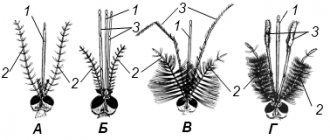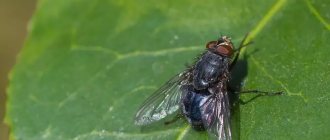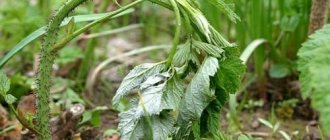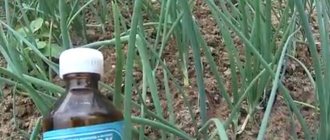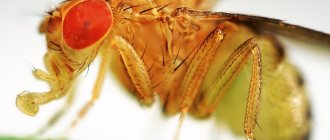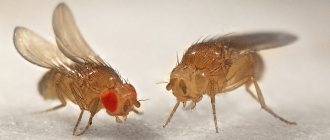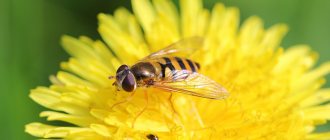House fly
The housefly or housefly is a representative of the family of True flies, which formed its own separate taxon in the course of evolution, splitting off from its wild relatives due to its attachment, so to speak, to human habitats rich in terms of food.
The answer to the question of what a fly looks like is easy to give. This pest cannot boast of anything outstanding in its appearance. This cheeky insect is usually no more than 1cm in length and has a simple gray body with a yellow tint to the lower abdomen. Also, the thoracic segment of the housefly has several black stripes, and a pair of compound eyes are located on the head. These are known to be flying insects that have two pairs of wings.
Flies are extremely fertile, and this is the main danger of allowing their uncontrolled reproduction in conditions of close living with humans. One female individual can lay more than a hundred eggs at a time, and the reproductive period of these insects lasts their entire short life.
No wonder there is a saying “they breed like flies.” But we will talk about the reproduction features of these pests in more detail a little later.
As promised, in this review we will take a closer look at the analysis of the housefly’s lifestyle; learn how flies reproduce; Let’s determine what determines the lifespan of a fly.
Now we propose to go through all stages of the life of this insect in order to track the entire cycle of their existence. So, let's go.
Flies are different
When we talk about flies, we mean representatives of the order Diptera, class Insecta, of which there are about 75 thousand species. Some varieties are harmless, others sting and bite. There are flies whose reproduction goes through several stages, and there are also viviparous ones.
They live all over the globe. But with all their diversity, in this article we will talk about synanthropic species of flies - those that live in close proximity to us. We know them well, these are:
- House fly (Musca domestica).
- Blue (Calliphora vicina) and green (Lucilia sericata) blowflies.
- Fruit fly or fruit fly (Drosophila melanogaster).
In addition to these most famous representatives, 5 more species of burner flies, representatives of the family Hippoboscidae, live in Russia. In appearance they are similar to house flies, but the difference is that live flies (autumn, horse, sheep) are active bloodsuckers. They are the ones who sting people and animals in late summer and autumn.
And yet most flies feed on any organic matter. But they prefer sweets more. Moreover, they can distinguish sugar from saccharin unmistakably. Although there are specialized types. For example, the larvae of cheese flies (Piophila casei) feed exclusively on cheese.
Types and habitat of insects
Common types of flies include:
- A house type of insect;
- Indoor;
- Market;
- Green carrion species;
- Meat type (medicinal).
Interesting! Treatment with the larvae of meat flies is considered quite effective and even stops the development of gangrene in humans.
The most common type of fly is its indoor representative, which is a synanthropic organism and belongs to dipterous insects. It is practically not found in the undomesticated environment.
Favorable environments for the development of larvae of this species are places with an abundance of organic residues, manure, and food waste. The homeland of Musca domestica is the steppes of Central Asia. In Russia, this fly species is described by two subspecies - M. domestica domestica L. and M. domestica vicina Mcq. To date, the described insects have spread to all existing continents, cities and rural areas.
Anatomical features of the housefly
The hairy body of a fly is divided into three main sections, represented by the abdomen, thorax and head. The last section, in the form of a hemispherical shape, has a rather simplified appearance at the back, and is convex at the front.
The eyes of the representative of the indoor species have a facet system, are large in size and dark red in color. In females, the distance between the eyes is equal to the size of the existing organ of vision, in males it is equal to 2/3 of its length.
Between the existing eyes the fly has a forehead, the middle part of which is marked by the so-called frontal stripe, bounded on the sides by two rows of bristles. In males it is considered to be quite narrow, especially when compared with the frontal stripe of the female.
Between the inner edges of the eyes and the frontal strip are located the eye orbits, framed downward by the cheekbones and upward by dark plates. The orbits and cheekbones of the insect are covered with small hairs of a yellow or silver hue.
Under the existing arcuate suture on the “front” part of the insect there are thin antennae, in the form of antennas, which are the organs of smell.
The fly is equipped with three pairs of legs, which in turn are divided into 5 more parts. The last part is the insect's feet. The fly moves on claws, under which there are so-called sticky pads, allowing the insect to easily run along steep walls and ceilings.
The length of a housefly can reach 8 mm. The insect is colored gray, where the abdomen has a yellow tint, and the chest is decorated with four stripes in black. If we compare flies with each other, the females of this species are much larger than the males.
During flight, the fly uses exclusively the front pair of wings, while the back one acts as the so-called balance organ. With the help of halteres (the back pair of wings) and the receptors located on them, a fly can easily determine its location. Without halteres, the fly will be completely disoriented in space.
Photos of fly halteres
Lifespan
In its development, the insect goes through 3 stages lasting from 8 to 20 days. The life cycle of house flies is defined as 2-4 weeks, but there are individuals that live much longer.
The lifespan of insects is affected by their habitat. For normal existence of the insect, a temperature range of 20-25 is indicated. Having survived the winter period in a room with low temperatures, the fly thereby increases its life cycle. Fertilized female flies, pupae and larvae endure the cold period of the year in a sleepy state without displaying any activity. With the arrival of spring, when the air temperature reaches at least 10, the flies awaken.
Life cycle and features
Flies are insects with complete metamorphosis. This means that the reproduction and development of a fly goes through several stages, namely egg, larva, pupa, and adult. All stages of the life cycle differ in habitat, feeding method and morphology.
Reproduction of flies (meat flies, house flies and others) begins from the moment of mating of individuals at the adult stage. Males attract females using sound signals they make with their halteres. Fertilization occurs inside the female's body.
On average, after 2 days the female lays up to 200 eggs and is again ready to mate. If all the eggs of one fly survived, then during her entire life, which lasts up to 2 months, the female would give birth to 3 thousand offspring. This is 8-9 generations, which would increase the number of descendants of the first fly to 5 trillion individuals. This is the amazing rate of reproduction of flies.
The full cycle of transformations from egg to adult in flies takes 10-20 days and depends on temperature.
Types of flies, nutrition and life cycle
Among several hundred species of flies, which, according to biological classification, scientists attribute to the family of dipterous insects, there are several of the most common: house flies, market flies, meat flies, etc.
The life cycle of an insect consists of 4 main stages and lasts 8-20 days:
- laying eggs that remain in this state for 1 day;
- appearance of larvae;
- transforming them into pupae;
- emergence of adults.
A fly is an insect with a complete development cycle (complete transformation - holometamorphosis),
which includes the following stages:
- Egg. It takes from 8 to 50 hours to mature, then the formed worm comes out.
- Larva. In the period from 3 to 20 days, fly larvae feed, grow, and molt. After the last molt they turn into a prepupa - the body becomes short and thick. While standing, they find a cool, dry place (they bury themselves in the ground or sand), where they finally pupate. The skin (cuticle) hardens, forming a protective shell - the puparium.
- Doll. A fly is formed inside the puparia within 3-5 days.
- Imago (adult). After 1.5 days, the female is ready for mating.
Under favorable conditions (23-25 ˚C, sufficient food), the fly can live up to 2 months. Larvae, pupae, and fertilized females hibernate at low temperatures, and awaken when warming reaches 10 °C.
Features of the reproductive organ
The reproductive organ of the female of the described insect consists of:
- Of two dimensional ovaries;
- Paired oviducts;
- Unpaired oviducts;
- Vaginas;
- Three seminal receptacles;
- Two pairs of accessory glands.
Ovaries and uterus of a fly photo.
The ovaries are represented by a large number of egg tubes, divided by certain constrictions into several parts for the development of follicles in them. The components of the oviduct are represented by a terminal filament and a chamber, as well as a tube with a stalk for connection with the paired oviduct. The terminal chamber consists of cells necessary for the further development of follicles.
Follicles develop sequentially, beginning during the pupal phase. The end is considered to be the adult (definitive) stage of insect development.
During oviposition, fertilization is occupied by an unpaired oviduct, which has the shape of a cylindrical tube. The existing spermatic receptacles consist of capitate reservoirs and ducts connected to the unpaired oviduct. The accessory glands, tubular and saccular, close with the oviduct, secreting a certain secretion, thanks to which the existing eggs are glued to the substrate.
How flies reproduce
Scientists believe there are approximately 5,000 species of flies. Some of them don't bother people at all. But synanthropic species live next to humans and are carriers of bacteria and pathogens of many diseases. To combat them successfully, you need to understand how flies reproduce.
Features of reproduction
The reproductive organ of the female fly includes:
- two fairly large ovaries;
- paired oviducts;
- unpaired oviduct;
- vagina;
- three seminal receptacles;
- two pairs of accessory glands.
The ovaries are a large number of egg tubes, which are divided by special constrictions into several sections where follicles develop. The egg tube contains a terminal filament, a terminal chamber, and an egg tube with a stalk, which connects to the paired oviduct. The terminal chamber contains cells that are necessary for the formation of follicles.
The seminal receptacles have capitate reservoirs and ducts that are connected to the unpaired oviduct. Tubular and saccular accessory glands connect to the oviduct and secrete a special secretion, with the help of which the eggs stick to the substrate.
Laying eggs
Reproduction of flies begins with the laying of eggs. Most often this occurs in pig, bird or horse manure, in rotten wounds, carrion, spoiled meat, rotten vegetables or fruits, and garbage. When searching for a suitable place for laying eggs and the future development of larvae, females use the olfactory organs, which are located on the antenna segments.
However, smell alone is not enough - before laying eggs, the female tastes the substrate several times with her proboscis. In all likelihood, taste irritation is also taken into account. If for some reason the substrate is unsuitable for laying eggs, the fly looks for another place. It should be noted that vision does not take part in the search process.
Larval development
The number of eggs that a housefly can lay at one time is about 150. Their size is approximately 1.2 mm. Within 24 hours after laying, larvae are born. In appearance they look like thin white threads. This phase of life is called the nutritional phase and usually lasts for 5-6 days.
During this time, the larvae penetrate deep into organic waste, since it is much warmer and more moisture there.
In addition, in this way they hide from the sun's rays, which have a detrimental effect on them. After about a week, the size of the larva becomes much larger and it becomes brown in color.
At the end of the feeding phase, the larva pupates, in which it remains for up to 6 days.
The emergence of an adult fly capable of reproduction occurs about two weeks after the female lays her eggs. After “birth”, flies spend some time in a calm state. Only after a few days, when their wings are completely dry and strong, do insects become able to fly.
Flies: Video
after the fuck☹️the maggots come out of the fly. How a fly gives birth. We deliver birth to a fly
Birth and death of a fly in 3 minutes
The process of mating in flies, after which eggs are laid, larvae and adult flies appear
joyful birth of a fly.avi
Source: https://beyklopov.ru/moshki/obschie/kak-muhi-razmnozhayutsya.html
Stages of development
Most insects are characterized by developmental metamorphosis in several stages. The fly is no exception. In the life of this insect, all the traditional four stages are present, during which this pest goes through its entire life path.
So, let's list these 4 phases of life and development of a fly, they are as follows:
- egg;
- larva;
- chrysalis;
- adult.
Now let's go through each of these four stages in more detail. Let's find out how long it takes an insect to pass through each of them, and how they are characteristic.
Egg
As already mentioned, one female fly can lay up to 120 eggs at a time. Usually, for laying, these insects choose the places most suitable for the survival of their offspring in the first stage of life.
These include:
- all kinds of human waste;
- cattle manure and domestic animal excrement;
- corpses of dead animals;
- cesspools;
- rotten fruits and vegetables;
- rotten meat products.
It must be said that being in the egg state is the shortest development cycle of this insect. It takes just a day for the egg to metamorphose into a tiny larva.
During this one day, fly eggs that do not exceed 2 mm. in length, nourish the embryos located inside with yolk. After which, about 24 hours later, larvae emerge from the eggs.
Larva
Like a fly walking on the ceiling.
The larvae that have just hatched from the eggs resemble thin white threads that can barely be seen with the naked eye. When asked how long it takes for the larva to move to the next stage of development, let’s say that the insect usually stays in this state for about a week, more often not even more than 5 days.
The larva is usually very difficult to detect, since it avoids exposure to direct sunlight and tries to burrow as deeply as possible into the environment in which it was born. In the thickness of the nutritional substance, the larva gains the calories it needs for development.
It becomes fatter, becomes larger, changes its pale color to a brownish tint, after which it pupates, making the transition to a new stage of its existence.
Doll
The most passive stage of an insect's life is the stage of being in the form of a pupa. A fly pupa is formed by hardening the skin of the larva, which becomes the pupal case or puparium. Inside this case, the final metamorphosis occurs, during which the tissues of the larva disintegrate and a restructuring of all its systems occurs.
This is how the adult individual (imago) is formed, so familiar and easily recognized by everyone. How long does this transformation process take? Just 5 days, and another buzzing pest is born in all its “glory.”
Green (carrion)
Despite its partiality to various kinds of carrion and sewage, this fly is a very beautiful insect with a glossy emerald body and translucent smoky wings with a faint openwork pattern. Its body length is about 8 mm. The fly's eyes are large, reddish, its abdomen is round, its cheeks are white. Green flies live mainly in dirty places : on decaying animal corpses, in manure, waste - but sometimes they can be
meet among flowering plants with a strong aroma. They feed on organic rotting matter, where they lay their eggs.
After mating, the female lays about 180 eggs. The egg has a grayish or light yellow tint. She tries to hide them as deep as possible in carrion, where they develop within 6–48 hours to the larval stage. The length of the larvae's body varies between 10–14 mm. After 3–9 days they leave their habitat and move to the soil to pupate. The pupal stage lasts from 10 to 17 days (depending on weather conditions), after which the insect emerges to the surface as an adult fly.
Laying eggs
The described species of flies begins its reproduction process by laying eggs. Egg laying can occur:
- In a pile of pig, horse or poultry manure;
- They fell on rotting wounds;
- In spoiled meat components;
- In rotten vegetables or fruits;
- In garbage and rubbish.
To find the place where eggs are laid, the female uses the olfactory organs located on the antennae. But often the sense of smell alone is not enough in this matter, which is why the female, before laying eggs, uses her proboscis, using it to “taste” the substrate, so to speak. And if the substrate is not suitable, the female fly begins to search for a new place to lay her own eggs.
A housefly can lay up to 150 eggs at a time. The cycle of development and transformation of an insect from an egg into a fly takes about two weeks. Each egg is no more than 1.2 mm in size. As the embryos develop, they absorb the yolk and grow slowly. After a day, the fly eggs transform into thin and white legless larvae. The described stage of development of flies is called “nutritional”.
How many eggs does a fly lay?
The fly instinctively takes care of its offspring, selecting a suitable place to lay eggs. It should be a rotting, semi-liquid substance away from sunlight and potential enemies. The larvae do not have to look for food and hide - they live and develop in the same place where they emerged from the eggs.
The fly is guided to the laying sites by its olfactory organs - special antennas on the head (three-membered antennae). Then the female feels the substrate with her proboscis - tastes it for consistency and taste.
After making sure that the place is suitable, the insect produces a narrow tube (ovipositor) from the end of its abdomen and begins the laying process.
Where flies lay eggs:
- dung heaps;
- any corpses;
- cesspools and cesspools;
- dried fish, meat;
- rotten vegetables and fruits.
We invite you to familiarize yourself with: Leopard anti-flea spray for cats
https://www.youtube.com/watch?v=8zlnB6wW4bM
The fly lays its eggs in old purulent wounds on the body of living animals and birds. In some cases, clutches are found even in wet laundry. When it is put on the body, the worm can crawl into the urethra, causing genitourinary myiasis (inflammation of the urethra)
The larvae of common flies deposited in the external environment are harmless to humans. The danger is that if they are swallowed with food, intestinal myiases will develop (inflammation of the intestines caused by the introduction of a worm into its wall). In all other cases, fly larvae can even be useful.
They are recognized by official medicine as an effective means of cleaning foci of necrosis on the human body. Worms are launched into trophic ulcers, bedsores, and purulent wounds for quick, high-quality sanitation. They eat away all dead tissue without touching healthy tissue.
But there are insects that deliberately lay eggs under the skin of humans, animals, and rodents, causing skin myiases and even damage to internal organs. Flies whose larvae emerge from under the skin include: tumbu, Wohlfartova, and gadflies. The female gadfly is especially dangerous. Her interests include sheep, in whose skin she lays eggs, other animals, as well as people.
Common flies are one of the most common species of the family, which is also found in non-domesticated environments. Their lifespan depends on the ambient temperature, and therefore the full life cycle can take up to 4 weeks.
During its life, an insect undergoes 4 stages of development (egg, larva, pupa and adult).
Mating of insects occurs in the spring. The male fly climbs onto the back of the female, remaining in this position for some time. Sometimes flies also mate in flight: the male clasps the female with his legs and pinches her wings, flying into the air. This fertilization process is observed in hoverflies.
After copulation, the female goes in search of a suitable place where she will subsequently lay eggs. Moreover, the female is guided exclusively by the sense of smell and taste. Favorable places for laying eggs are places with all kinds of human waste, where there is an accumulation of rotten fruits and vegetables, rotten meat products, as well as cattle manure.
Life cycle of a fly
Having found a secluded place, a pregnant fly lays about a hundred eggs, the length of which does not exceed 1 mm. After a few hours, they become worm-like, legless larvae, referred to by fishermen as maggots. This period of development can vary: at home it usually takes about 8 hours, but if the eggs laid by a fly develop in nature, then the larvae from them can appear after 20 hours.
Lifespan of a fly
On average, flies live 2-3 weeks. Depending on some factors, this indicator may change down or up.
Ordinary
House flies most often live about 30 days. However, under favorable conditions, the lifespan of a common fly can increase to 2 months. In addition, when cold weather sets in, the adult (just like the larva) can go into an inactive state (anabiosis) and overwinter in this form. In spring, the fly “wakes up” when the air temperature rises above +10 °C.
The length of time an ordinary fly lives in an apartment largely depends on how long the people living in this apartment will allow the presence of a very annoying guest.
Ktyr
A close relative of the common fly is the ktyr. This is a predatory insect on dragonflies, wasps and bees, butterflies. It is not dangerous for humans, but it can bite in life-threatening conditions: for example, when it is caught and held in the hand
Attention! The lifespan of flies from this family is 1-2 months. Despite the fact that they also actively reproduce, many species are now listed in the Red Book due to the widespread use of insecticides. But the ktyr is a fly that benefits humans by regulating the numbers of many other insects.
Sciarides
Sciarida is a small fly whose food is rotting vegetables and fruits. The larvae live and develop in the soil, eating roots. Thus, these insects can cause significant damage to agricultural crops and ornamental garden plants.
The lifespan of an adult sciarid fly is very short: about 7 days. However, a week is enough for the female to lay up to 300 eggs.
Drosophila
Each of us has probably seen the fruit fly Drosophila at least once in our home. As soon as a fruit or vegetable gets stale and begins to rot, this insect is right there.
Drosophila is small in size and has the same short lifespan - 10-20 days.
How long Drosophila flies will live in an apartment directly depends on the availability of food. If you remove the food source from the house, the fly will not survive even a few days.
Flesh and carrion flies
The blowfly is a lover of rotting meat. It is in it that she lays eggs or larvae (the gray blowfly is viviparous).
A carrion fly can live no more than 10-12 days. Although most often her life expectancy is even shorter: only about a week.
Reproduction of flies
When masses of buzzing insects appear in a home from nowhere, the owner of the house has two questions: how do flies appear in the apartment and what to do about it. Two types feel most at ease in human housing:
- common or house fly;
- Drosophila fruit fly.
These species are practically omnivorous. For the development of offspring, only dampness and decaying organic matter are required. Sometimes you can come across the statement that the house fly is not able to survive outside human habitation. But before the advent of civilization, it somehow existed. House flies are called so because they have found very favorable conditions for reproduction near homes. These flies mainly breed and live in rural areas. Their larvae are well suited for development in warm, moist manure from domestic animals. In the city, their habitat is garbage cans. They will appear in the apartment only in unsanitary conditions.
On a note!
Fruit flies only need a small amount of rotten fruit or a dirty trash can to thrive.
Stages of development
Some flies mate just a couple of hours after emerging from the puparium. It takes 36 hours for a housefly to reach sexual maturity. The female only needs copulation once in her entire life. After mating, she begins to lay eggs. Depending on the species, they lay from several tens to 2 thousand pieces over their lifetime.
Viviparous species
These representatives are characterized by rather low “productivity” due to the greater protection of the larvae. The Wohlfarth fly is a viviparous species found in Europe. In Africa, this species is the tsetse.
The developmental stage from egg to larva takes place latently in the abdomen of the female. Flies lay larvae that are ready for independent life. In tsetse they immediately burrow into the soil and pupate. In Wohlfarthova, the maggot parasitizes living organisms. Once on the body of an animal or person, the larva bites into soft tissue. It spends all three larval phases under the skin of the host. To pupate, it climbs out and buries itself in the ground.
Gadflies
These large flies occupy an intermediate stage between oviparous and Wohlfart. Gadfly larvae also parasitize living organisms, but they reach the host in the egg stage.
The gastric botfly lays eggs on animal fur. When they lick the eggs from the fur, they end up in the stomach. Only after this does the larva emerge and begin its development in the host’s gastrointestinal tract.
The subcutaneous lays eggs on the fur. The emerging individual independently goes deep under the skin, where it passes through all stages of development in safety, leaving the host only before pupation. Sheep and horse gadflies "splash" eggs into the eyes and nasal cavities of animals in the same way as the Wohlfarth fly does with larvae.
Appearance
Body length is 9 mm-2.5 cm. An adult has a wide head with large eyes and short antennae. There is no proboscis, or it is reduced. The legs are massive and short. The abdomen is round or conical. The entire body is covered with coarse hairs. The life of gadflies is short - approximately 22 days.
Classification
- Hypodermatinae (Subcutaneous). Adults lay eggs on the hair of domestic animals: horses, rams, cows. The hatched larvae penetrate the skin and move through the tissues. Before entering stage II, they gather under the skin, forming inflamed fistulas. Through them the larvae get to the surface.
- Gasterophilinae (Stomach). There are 2 ways for larvae to enter. Some females lay eggs on leaf food, and they enter the animal with food. Others - on the head and chest. The cattle, by biting and licking the skin, transfer the eggs into the digestive tract.
- Oestrinae (Cavity, nasopharyngeal). Females release eggs in flight, which land on the mucous membranes of the eyes and nose. People often suffer unwittingly: as a result, conjunctivitis (very dangerous for a child) and other diseases can develop.
Some scientists classify Cuterebrinae, the American subcutaneous gadfly, as a separate subfamily. They most often parasitize mice, hares, gophers, etc.
Danger to humans
Some subcutaneous species, such as Dermatobia hominis, attack humans. Bodfly larvae penetrate the skin, causing a lot of suffering. Cases have been recorded where a person died from the penetration of parasites.
Gadflies are inventive in attack: some distract, others attack. Their legs are soft, so you may not notice when a fly lands on your skin. But its bite is very painful, burning. Redness appears in this place and itching begins.
Human blood serves as a breeding ground for eggs. The hatched larvae, looking for a way out, move upward. If they get into the brain, death is inevitable.
Methods for controlling fly larvae
Maggots are destroyed to prevent the appearance of flies,
which are carriers of pathogens of dangerous diseases:
- typhus;
- dysentery;
- salmonellosis;
- conjunctivitis;
- tuberculosis.
Each individual carries about 6 million different bacteria. Timely destruction of the larvae eliminates the need to fight flies.
Target areas for treatment include cesspools, manure and compost heaps, barnyard burial grounds, garbage chutes in houses and garbage containers in the local area. After removing such sources of maggots, you also need to treat the soil where they burrow for pupation.
Chemicals
Preparations for killing lice, ticks, fly larvae, bedbugs, and moths are called “larvicides.” They have a detrimental effect on the insect even before the end of its development.
Main types:
- inhibitors of chitin formation. Active substances paralyze the molting process, as a result of which the larva dies;
- chemical (chlorantraniliprole, hexachlorane, dieldrin). They paralyze the respiratory, digestive and nervous systems, including adults;
- biological (“Bacticide”, “Larviol”). Bacterial toxins decompose the larva's digestive tract.
The main types of chemical aqueous solutions of insecticides:
- 0.3-0.5% disecryl;
- 1% karbofos;
- 0.2% trochlovos;
- 0.5% dichlorvos;
- 2% chlorophos.
Chemicals must be diluted in warm water, stirring constantly. Places where flies accumulate are watered with the solution. Consumption rate – from 200 to 1000 l per 1 m2. The frequency of treatments is from 2 to 5 times a month (the drier, hotter the weather, the more often). The maggots die under the toxic film that forms.
In the garden, the following preparations can be used to treat manure heaps:
- iron sulfate (800 g per 10 l);
- quicklime;
- borax, boric calcium (1.2 kg of calcium, 1 kg of borax). The area is sprinkled with a powder mixture, then spilled with water;
- carbolic acid and sulfur (3:1).
Traditional methods
A cheap and effective method of getting rid of fly larvae is to isolate the place where they accumulate from the air. The manure or garbage pile is covered with a thick piece of polyethylene, the edges are carefully pressed. The larvae will die from overheating.
Another method is to pour a strong solution of vinegar (4 glasses per bucket of water) or gasoline into the area where parasites accumulate. Some then use vegetable oil to create an impenetrable film.
Boiling water
Pouring boiling water over areas where fly larvae accumulate is the simplest measure to combat them, but it is not suitable for processing large piles of waste. Well suited for pouring into pipelines and garbage cans. Boiling water will destroy the larvae, eggs and most bacteria.
The development cycle of an adult fly from an egg is quite short, so you should not delay in destroying clutches and maggots. The easiest way to eliminate them is mechanically, but on a large scale chemicals are needed.
Meaning in nature
Flies become carriers of diseases unwillingly. And in nature their significance is enormous. Starting with the fact that these insects and their larvae are an important link in the food chain.
In addition, without flies our planet would be covered with a layer of rotting organic matter. By repeatedly passing organic waste through themselves, fly larvae return minerals and chemical elements to the cycle of substances in nature.
Many representatives of these dipterans are plant pollinators. And some (for example, blackbirds of the Asilidae family) are active predators that regulate the number of other insects. And, by the way, they are used as biological weapons against pests of forests and fields.
Prevention
Insects harm gardens, vegetable gardens, and park areas; young cuttings, leaves, and shoots, which people lovingly grow, especially suffer from the larvae.
In addition, flies are carriers of dangerous diseases. Breeding these insects is not worthwhile, so you need to follow simple rules:
- carry out regular cleaning;
- Take out the trash can every day, which must always be closed;
- do not leave food waste on the table;
- seal fruits, vegetables, meat, fish or put them in the refrigerator;
- monitor the condition of mosquito nets.
Knowing the patterns and characteristics of the reproduction of flies, you can choose effective means of combating them.
Sources
- https://klopkan.ru/muhi/razmnozhenie-muh-organy-razmnozheniya-vykladka-yaits-razvitie-lichinok-i-zhiznennyy-tsikl/
- https://FB.ru/article/417469/razmnojenie-muh-organyi-razmnojeniya-vyikladka-yaits-razvitie-lichinok-i-jiznennyiy-tsikl
- https://poklopu.ru/muhi/razmnozhenie-muh.html
- https://eparazit.ru/lichinki-mux.html
- https://WikiParazit.ru/babochki-i-moshki/prodolzhitelnost-zhizni-muhi.html
- https://obnaruzhil.ru/muhi/kak-razmnozhayutsya-muxi.html
[collapse]
Preventive measures
Do not forget that these winged insects are spreaders of various diseases:
- tuberculosis;
- helminthic infestation;
- intestinal infections;
- food poisoning;
- anthrax;
- brucellosis.
Even windows with mosquito nets and closed doors will not protect you from the invasion of hordes of flying insects. They can enter the house in other ways. How to get rid of this scourge?
Since the parasites are quite small, this allows them to easily penetrate any holes and cracks, including through ventilation shafts. Even the doors to the entrance must be closed constantly, since this is the easiest way for them to enter.
Important! The best preventive measure against the appearance of flies is regular cleaning of the room, and especially the kitchen. Do not leave leftover food, vegetables and fruits in accessible places, and also try to take out the trash in a timely manner.
The best preventative measure against pests is regular cleaning of the premises.
